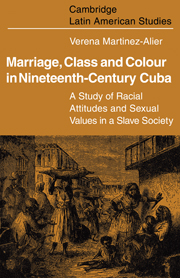 Marriage, Class and Colour in Nineteenth Century Cuba
Marriage, Class and Colour in Nineteenth Century Cuba Book contents
- Frontmatter
- Contents
- Preface
- List of abbreviations
- INTRODUCTION
- PART ONE INTERRACIAL MARRIAGE
- 1 Intermarriage and family honour
- 2 Intermarriage and politics
- 3 Intermarriage and Catholic doctrine
- 4 The white man's view
- 5 Colour as a symbol of social status
- 6 Intraracial marriage
- PART TWO HONOUR AND CLASS
- Appendix: Three Cuban genealogies
- Notes to the text
- Bibliography
- Index
4 - The white man's view
Published online by Cambridge University Press: 09 October 2009
- Frontmatter
- Contents
- Preface
- List of abbreviations
- INTRODUCTION
- PART ONE INTERRACIAL MARRIAGE
- 1 Intermarriage and family honour
- 2 Intermarriage and politics
- 3 Intermarriage and Catholic doctrine
- 4 The white man's view
- 5 Colour as a symbol of social status
- 6 Intraracial marriage
- PART TWO HONOUR AND CLASS
- Appendix: Three Cuban genealogies
- Notes to the text
- Bibliography
- Index
Summary
THE SEX RATIO AND FREQUENCY OF INTERMARRIAGE
Sentiment in nineteenth-century Cuba was in good part hostile to interracial marriage. Nevertheless, throughout the century some 250 whites were keen enough to marry across the colour bar to apply for government licence to do so. A factor relevant to the probability of interracial unions is the sex composition of the population. Table 2 gives the population figures by colour, status and sex from 1817 to 1862. It is possible to give age specific figures for three years, and to break them down by shade of the free coloured for two years (Tables 2a, 2b and 2c).
Throughout the century, there were 114 adult white men (1827), or 127 (1846), or 150 (1862) for every 100 adult white women. In the free coloured population, however, women outnumbered men. These two sectors, namely the white and the free coloured, generally furnished the partners to interracial unions. A considerable percentage of white males, unless they decided to remain celibate, had to resort to the coloured community for their women.
Some contemporaries also attribute the existence of interracial marriage to the white population's disparate sex ratio. As one official argues, ‘bearing in mind that [he] … is of humble status … it would be difficult if not impossible for him to contract marriage with a white person’.
- Type
- Chapter
- Information
- Marriage, Class and Colour in Nineteenth Century CubaA Study of Racial Attitudes and Sexual Values in a Slave Society, pp. 57 - 70Publisher: Cambridge University PressPrint publication year: 1974


